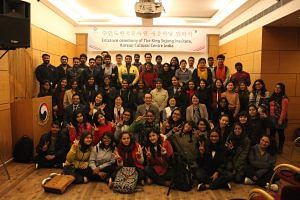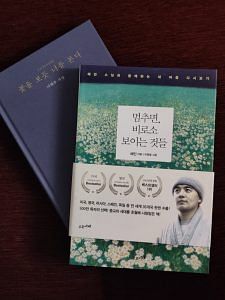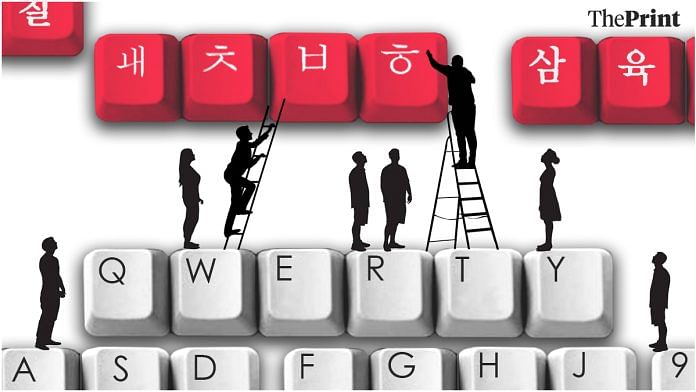New Delhi: Surbhi Sharma’s room is a window into her hybrid life: The study-cum-coffee table sports a yoga book, a Premchand novel and a children’s storybook in Korean. The steel almirah full of Korean study material has a Ganesha sticker on the outside. And her elder sister’s most prized possession is a CD by K-pop band EXO.
Most days, the three Sharma sisters – two of whom do not wish to be named – switch effortlessly between Hindi, English and Korean, helping each other understand Korean grammar patterns and navigate tricky pronunciations. Over the past decade, homes like these have been at the heart of a new Korean language resurgence in India – a cultural byproduct of the raging fan following that K-pop and K-drama enjoy across the world.
Last month, Surbhi – the youngest of the trio, completed a month-long intensive course conducted by King Sejong Institute (KSI), a language institute affiliated with the government of South Korea, for learners aiming to clear ‘TOPIK’ – Test of Proficiency in Korean – a certificate integral for pursuing a career in Korean companies.

The family’s engagement with Korean started in 2016, when the eldest sister enrolled in KSI. Seven years have passed since, and the foreign language has metamorphosed into a fundamental presence in the Sharma universe. Surbhi’s other sister is awaiting to enrol in a postgraduate programme in Korean language at Jamia Millia Islamia.
The Sharmas’ steadfast engagement with Korean exemplifies India’s growing fascination with all things K-culture. Varsities such as the University of Delhi are rushing to include more Korean courses. The South Korean government has opened six language institutes across India since 2012, and the number of TOPIK exam takers is swelling by the year. However, the country’s connection with Korean goes back 30 years and is better understood in two phases.
“Initially, we didn’t think any foreign culture could take over in India because we are so rooted in our own,” says Vyjayanti Raghavan, a retired professor from Jawaharlal Nehru University’s Centre for Korean Studies, while recalling how the ‘Korean wave’ or ‘Hallyu’ missed India in the early 2000s when it was spreading rapidly in several parts of the world, especially countries in East and Southeast Asia.
Raghavan, whose first brush with the language happened at JNU in 1976, has witnessed several phases of India’s tryst with South Korea.
“India was very much in their [South Korea’s] vision always because they looked at the huge market, the possibility and potential of our youth,” she says.
So, while there was no movement on the cultural front before the 2010s, Korean companies were steadily gaining a foothold in the country.
Also read:
First came K-firms, then Korean language
India’s economic liberalisation policy set the course for the arrival of Korean companies. Raghavan mentioned that firms such as Samsung, LG and Daewoo were the first to enter when India opened its markets in the 1990s.
“They take the plunge, and then they work their way through. That is what makes them successful entrepreneurs and successful firms because they are willing to take the risk and they are willing to explore new areas,” says the former professor, who was honoured with the South Korean Prime Minister’s Award in 2015 for her contribution to the advancement of the Korean language.
Korean language soon became the cornerstone of an emerging connection between driven Indian youth and Seoul’s corporate giants.
“Once investments came in, you got a lot of students joining it [Korean language course in JNU] because of the job opportunities it promised,” Raghavan said.
In the late ‘90s, scholarships by Korean firms made the language more attractive to Indian students. The South Korean government also welcomed one or two Indian students annually to their country to pursue higher education. However, the good run met its end in 1997, when the Asian financial crisis spelt doom in the East Asian nation.
Also read: This Korean man grew up to be a Bihari. Now his next goal is to sing with Armaan Malik
K-culture, language ties 2.0
At the turn of the new century, the Korean wave reached foreign shores, gaining swathes of fans in countries such as Japan and China.
South Korea is sensitive about its ‘brand image’, says Raghavan. “The moment they sense that it is becoming attractive, the [South Korean] government puts in a lot of effort and investment in developing that field.”
The country’s culture and information ministry saw immense potential in this growing cultural phenomenon, and got into the fray of developing television serials that were attractive to other countries. “The government gets into the [country’s] aim of promoting its culture abroad. After all, South Korea is a very small country with very little resources to export,” she says.
It was this calculated approach that led to the setting up of the Korean Cultural Centre (KCCI) in Delhi, the Korean Embassy’s cultural arm, in 2012, years before K-pop exploded in India. KCCI hustled when no one was looking and helped lay the foundation of a strong community of Korean culture aficionados – consisting mostly of young Indians – by organising K-pop contests, operating the KSI and organising the TOPIK exam.
India was yet to be hit by the Korean culture tsunami, but affordable internet and the subsequent arrival of streaming platforms in the early 2010s allowed sections of Indians to steadily access Korean content. As the audience base expanded organically, a new category of language learners was birthed – those who pursued it for their interest in Korean pop culture. They were led by their passion for understanding Korean songs, watching K-dramas without subtitles and keeping up-to-date with the latest celebrity gossip.
Anjani Goel, now a final year graduate student of psychology, got introduced to Korean culture through K-pop music videos on YouTube as a school student in 2016. Today, her phone configuration is in Korean, and so is her Gmail.
“Back then, I didn’t know something like K-pop even existed. They sent me two songs over WhatsApp. The songs were catchy; I really liked them. But I didn’t understand what they were saying. So, I googled and gradually started studying the language on my own,” says Goel, who enrolled at KSI in 2017 to formally learn the language.
For the next four years, she juggled college during weekdays and language classes over the weekends.
“I had no holiday for four years. But it was worth it. The classes were an escape from regular routine. I feel very happy that I pursued my hobby and made good friends in the process,” she says, recalling that the KCCI premises became like her second home.
So, when the announcement for TOPIK classes dropped last month, Anjani signed up quickly. Unlike her experience of learning French, a compulsory requirement at her school, she yearned to resume her Korean lessons in a physical classroom.
In the interim, the Korean government’s cultural incentives of the ‘90s, such as sending Indian students to Korea, received a facelift. The purpose of learning Korean, which till then was largely for employment or academia, was diversifying. Winners of K-pop contests, quizzes on Korea, and Korean speaking competitions, hosted by the Korean government with generous sponsorship from Korean conglomerates, were now getting the chance to visit and study the language in South Korea. Avenues were created to ensure that interest in Korean culture was sustained through State support.
In a decade since its inception, KCCI has transformed into India’s go-to point for information on Korean culture. In fact, the centre is now focused on moving beyond K-pop to introduce other cultural aspects of the Korean peninsula to audiences here – such as Korean musicals, orchestra, artwork, and cuisine.
Also read: South Korean skincare won’t always work for Indians. But here’s their secret to flawless skin
Spike in Korean language learners
Running parallel to and complementing the efforts of KCCI is its language school KSI, which also opened its doors to eager learners in 2012. By 2019, KSI had to introduce personal interviews at the beginner’s level to steer through the flood of applicants.
Lee Young Sook, a teacher at KSI Delhi since 2014, noted that students are more serious about learning Korean now.
“Earlier, students approached the classes more like a hobby. But nowadays, I think there has been an increase in the number of students who are already aware of KSI’s reputation and enrol with a focus on career or specialisation in mind,” she says.
Last year, more than 9,500 students learnt the language at the centre across three semesters, through online and offline classes. The hefty cost of lessons hasn’t stalled people from seeking admission; KSI charges nearly Rs 17,600 each semester for intermediate and higher level courses and Rs 19,000 for a professional course.
Paradoxically, the institute started offering free classes for the coveted TOPIK exam last year. In June 2023, six batches with at least 10 students sat through classes spanning 12 days, dedicating at least four hours a day to immersive learning.
“As students have only one chance at TOPIK in 2023, the Korean Cultural Centre India wished to help TOPIK aspirants prepare to the best of their ability,” the KSI told ThePrint over email.
The institute was true to its words. Lee, who helmed the class for Levels V-VI, meticulously prepared slides for every session and generously doled out coloured printouts comprising notes and practice sheets.
Career goals important for students
In Lee’s experience, many students start learning Korean for simple reasons, such as an interest in K-pop or K-drama. But something fundamental changes as classes progress. Students begin to express the desire to study at a Korean university or work at a Korean company. And that’s where TOPIK becomes essential.
“From the perspective of a teacher, whether a student is receiving the lessons by paying money or for free is not important. A class is a class, so preparation for it is the same,” she says.
TOPIK exam takers in India have nearly doubled in the last six years. A total of 393 registrations were received for the 57th TOPIK exam in 2018. For the 83rd TOPIK conducted last year, the registrations soared to 779. This was after registrations started happening online. Students call the process “a battle” as TOPIK forms have often been filled within five minutes.
“I have rarely seen anyone pursue the language for pleasure,” says a PhD scholar in Korean studies from JNU, who wishes to remain anonymous. They, however, underlined that it largely applied to people who studied Korean at a public university.
Career is always at the back of learners’ minds, they note. The staggering interest of Indians in the language has led to an unforeseen rise in the number of job seekers.
Furthermore, the scholar says that the earnings of those in the tourism industry, which is heavily dependent on Korean language translators, have dropped from Rs 6-7 lakh per annum to Rs 4-5 lakh. While Covid was a key reason for this slump, the increase in Korean language learners – and the rise in competition because of them – is also one.
“What happened to engineering graduates in the 1990s in India might happen to language now,” they warn. The research scholar also fears AI and says it could gobble up the remaining opportunities for translators.
But the Korean job market isn’t all grim for language enthusiasts. The South Korean Embassy puts the number of Korean companies doing business in India at 534, according to a report published in April.
For 29-year-old Ragui, who didn’t wish to divulge her first name, learning the language allowed her to find employment outside of her home state of Manipur, where the Korean wave reached in the 2000s.
Easy access to Korean TV channels like Arirang and KBS through local television networks exposed her to K-dramas and K-pop, eventually driving her to learn the language the moment she got a chance.
Her dream found wings when Manipur University and Korea Foundation started a Korean language course in 2019. She joined the free TOPIK course at KSI to reach TOPIK Level 6 – considered the pinnacle of Korean language proficiency.

Ragui, who lives in Gurugram and is currently employed with a Korean company, recalled that learning the language “didn’t feel so foreign” because she had watched so many K-dramas in her formative years. Although her day job requires her to interact with Korean nationals regularly, she still finds ways to personally engage with the language through poetry, self-help books and an English-Korean Bible.
“Instead of postponing your happiness until you’ve achieved your goal,
live a little and enjoy the moment.
Life is passing you by while you are waiting.”
Ragui holds on to these lines by Korean Zen Buddhist teacher Haemin Sunim from his best-selling book, Love for Imperfect Things.
(Edited by Zoya Bhatti)



